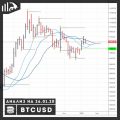This article is on the topic of stereotypes in trading with a transition to the issue of profit taking.
In previous postswe talked about services that can beuseful in trading if a person knows what risk management is and why statistics are needed (https://www.bitinsure.com/ as an example in crypto). Surprisingly, we received several comments that contained stereotypes both regarding risks (about them later separately), and about statistics and closing a position. We will cover all topics about. Let's start with taking profits. So, an article from the head of crypto:
Where they taught to always put feet, not to “catch knives” and not to average, they usually said that losses should be quickly fixed and profit should be increased.
Of course, like previous postulates, this has nothing to do with real trading.
Trying to work with a short table and with a longprofit will lead to the fact that positions in 90% of cases will be closed in steps that will slowly devour your deposit. Such tactics can work only on a long recoilless movement, which is rare on the market, and it is not at all a fact that you will be in a position to its beginning, given the constantly triggering stops.
What to do with profit to be in the black?
When deciding whether to fix or not to take profits, the trader chooses between "I will close, and the price will go on rising" and "I will not close, and the price will go down."
That is, between the fear of not making a possible profit, and the fear of losing the existing one.
The option “I closed, and the price immediately reversed” is the only option desired by the trader, but the chances of it are much less than the previous two.
When deciding on profit taking, consider the following:
Catch a U-turn and take profits at the peak(or at the bottom, if we are talking about a short position), it is possible near the previously confirmed resistance or support levels in case the price again cannot quickly go through these levels. For example, if now the price approaches 10300 and rests at this level, it makes sense to take profit, in whole or in part.
Evaluate your entry point (average entry price). If it is far and objectively unlikely to be able to re-enter at such a price, the position must be protected.
If it is not clear whether to close or not, lock partially.
If the entry price is good and the volume is small, wait for a small pullback and take it from the market. The entry price will become worse, but the volume will increase, which will provide good opportunities for partial fixation.
If the entry price is not particularly attractive, then it is better to fix or place a short stop on profit, otherwise a profitable position can quickly become unprofitable.
For example, if you now have a Bitcoin long with an entry price of 8,200, then there is not much chance of repeating such an entry, so you need to follow option 1 (keep the position or increase the volume).
And if the entry price is 9300, then it is better to close it entirely as soon as there are concerns about a possible price reduction.
Stops on profit are a useful tool.
In case of an unexpected reversal they helpsave your profit and get a good entry opportunity. Today my stops on long Bitcoin just below 10K closed a third of the position with an average entry price of 9700, I have already reached this volume at 9482 and improved the entry price.
It is also useful to separate short-term and medium-term trading.
In the first case we take local movements, in the second strategic ones.
For medium-term trading, a good margin of safety and a constant position in the direction of global movement are important.
We will talk about this topic separately.
If you have multiple coin positions,consider the correlation between assets. There is a long Bitcoin and Ether, both positions are in profit, but you do not know whether to fix or not, close one, hold the second, with a table for profit.
The same applies to altcoin positions against the dollar. The entire top altcoin grows and falls against the dollar almost synchronously, which gives freedom of maneuver.
Profit-taking throughout the position raises the price of error. Therefore, with the exception of some unambiguous situations that are not often on the market, partial fixation is always better.
You should not relax when the position is inarrived. Real profit is when it is already on the balance sheet. Therefore, do not let go of what the market has already given you. But don’t go to the other extreme, fixing micro-profits, otherwise you will simply lose good entry points.
All profitability!
In the following articles we will talk about bots, statistics and risks.


